Literature Review: Organisational Change Management - HRMT20028, 2019
VerifiedAdded on 2022/09/21
|12
|2797
|21
Report
AI Summary
This literature review examines organisational change management, exploring the significance of Human Resource Development (HRD) as an agent of change. It delves into internal and external factors driving organizational change, the roles of senior and line managers in facilitating and implementing change, and common causes of resistance to change. The review also covers steps for ensuring an effective change process and strategies for cultivating a change-capable culture. Furthermore, it highlights successful examples of companies that have undergone organizational changes, such as General Motors, Coca-Cola, Nokia, and Toyota. The review concludes by emphasizing the importance of organizational change for development and the role of managers in implementing effective strategies. The study is based on the assignment provided to a student of HRMT20028 – Organisational Change Management during Term 2 of 2019.
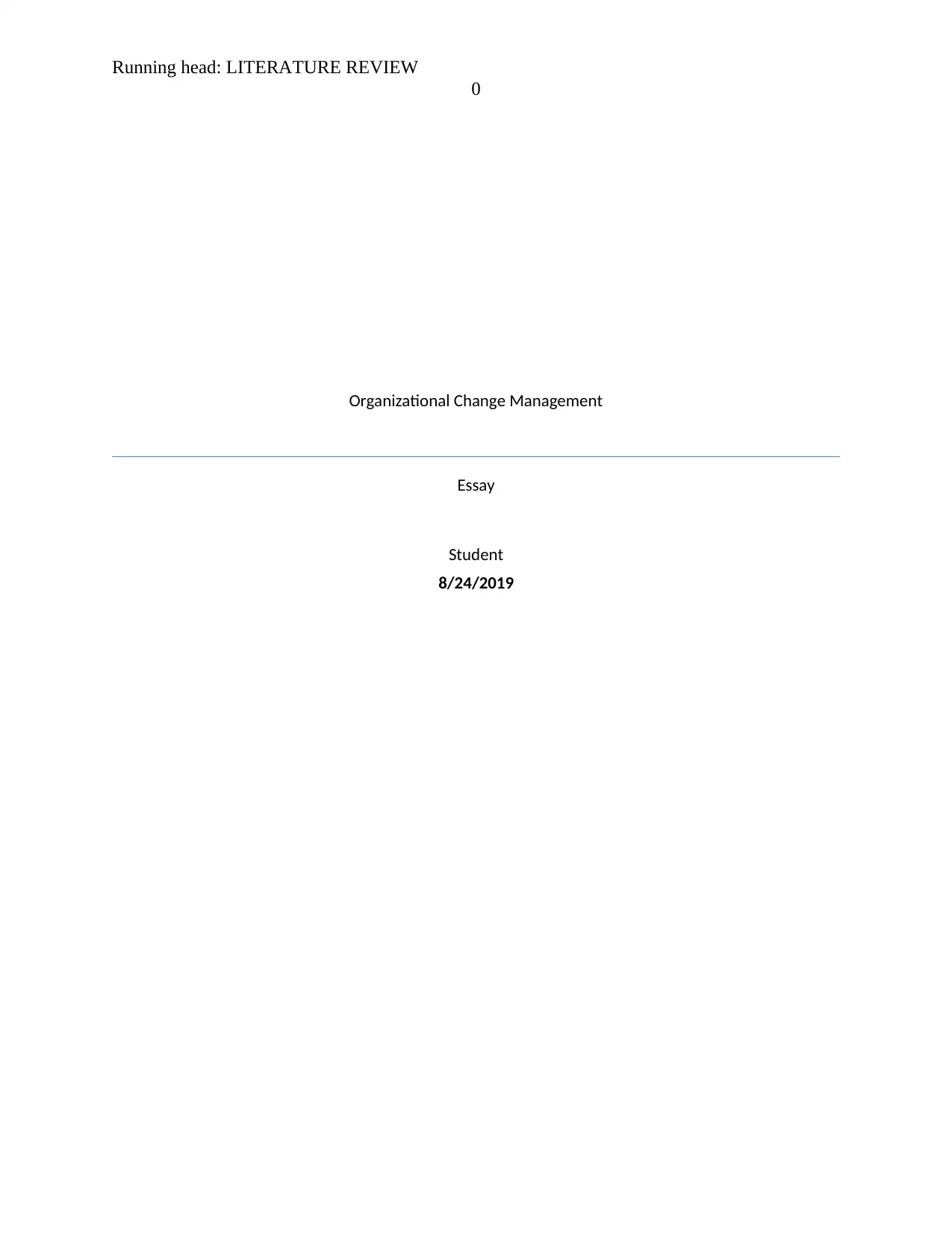
Running head: LITERATURE REVIEW
0
Organizational Change Management
Essay
Student
8/24/2019
0
Organizational Change Management
Essay
Student
8/24/2019
Paraphrase This Document
Need a fresh take? Get an instant paraphrase of this document with our AI Paraphraser
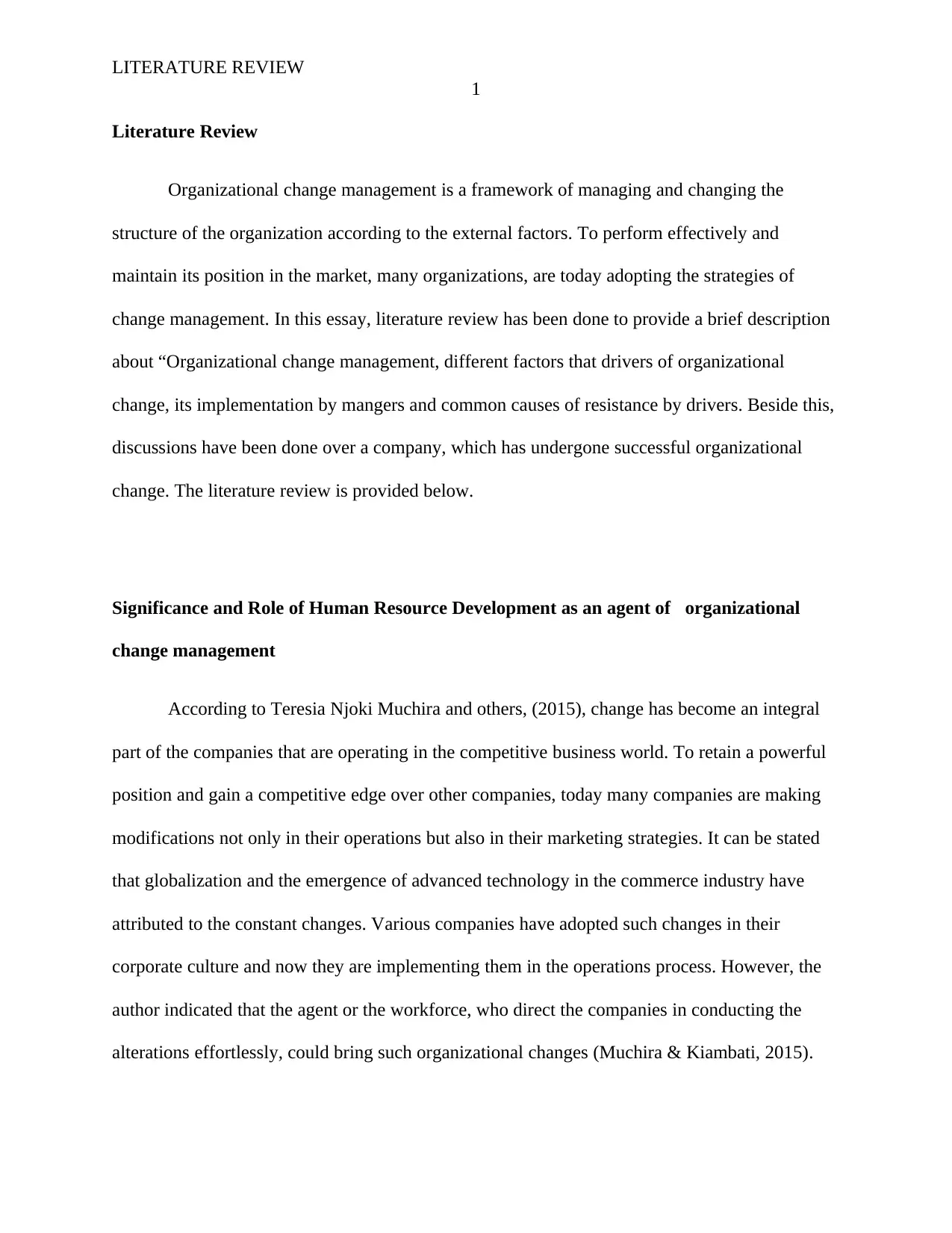
LITERATURE REVIEW
1
Literature Review
Organizational change management is a framework of managing and changing the
structure of the organization according to the external factors. To perform effectively and
maintain its position in the market, many organizations, are today adopting the strategies of
change management. In this essay, literature review has been done to provide a brief description
about “Organizational change management, different factors that drivers of organizational
change, its implementation by mangers and common causes of resistance by drivers. Beside this,
discussions have been done over a company, which has undergone successful organizational
change. The literature review is provided below.
Significance and Role of Human Resource Development as an agent of organizational
change management
According to Teresia Njoki Muchira and others, (2015), change has become an integral
part of the companies that are operating in the competitive business world. To retain a powerful
position and gain a competitive edge over other companies, today many companies are making
modifications not only in their operations but also in their marketing strategies. It can be stated
that globalization and the emergence of advanced technology in the commerce industry have
attributed to the constant changes. Various companies have adopted such changes in their
corporate culture and now they are implementing them in the operations process. However, the
author indicated that the agent or the workforce, who direct the companies in conducting the
alterations effortlessly, could bring such organizational changes (Muchira & Kiambati, 2015).
1
Literature Review
Organizational change management is a framework of managing and changing the
structure of the organization according to the external factors. To perform effectively and
maintain its position in the market, many organizations, are today adopting the strategies of
change management. In this essay, literature review has been done to provide a brief description
about “Organizational change management, different factors that drivers of organizational
change, its implementation by mangers and common causes of resistance by drivers. Beside this,
discussions have been done over a company, which has undergone successful organizational
change. The literature review is provided below.
Significance and Role of Human Resource Development as an agent of organizational
change management
According to Teresia Njoki Muchira and others, (2015), change has become an integral
part of the companies that are operating in the competitive business world. To retain a powerful
position and gain a competitive edge over other companies, today many companies are making
modifications not only in their operations but also in their marketing strategies. It can be stated
that globalization and the emergence of advanced technology in the commerce industry have
attributed to the constant changes. Various companies have adopted such changes in their
corporate culture and now they are implementing them in the operations process. However, the
author indicated that the agent or the workforce, who direct the companies in conducting the
alterations effortlessly, could bring such organizational changes (Muchira & Kiambati, 2015).
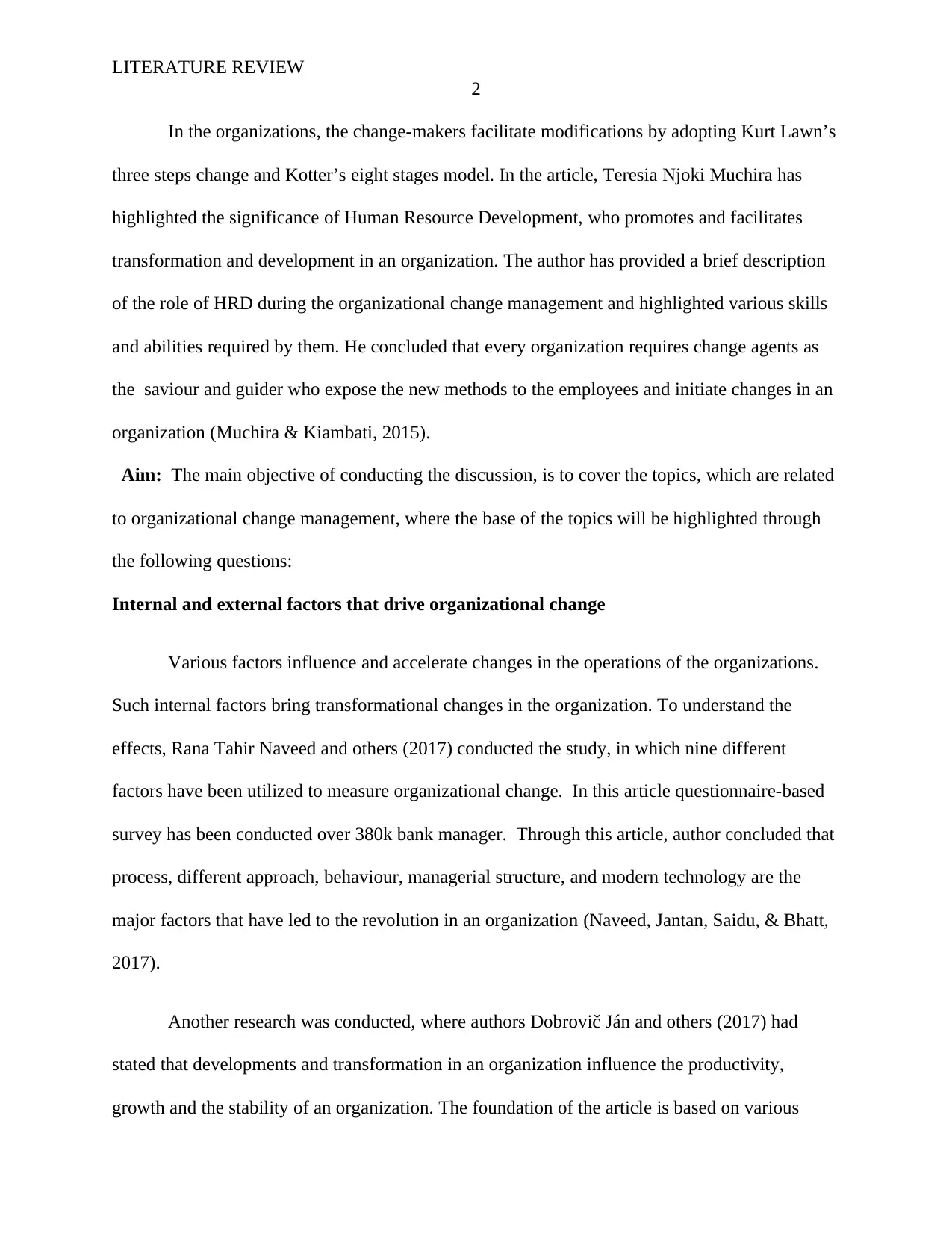
LITERATURE REVIEW
2
In the organizations, the change-makers facilitate modifications by adopting Kurt Lawn’s
three steps change and Kotter’s eight stages model. In the article, Teresia Njoki Muchira has
highlighted the significance of Human Resource Development, who promotes and facilitates
transformation and development in an organization. The author has provided a brief description
of the role of HRD during the organizational change management and highlighted various skills
and abilities required by them. He concluded that every organization requires change agents as
the saviour and guider who expose the new methods to the employees and initiate changes in an
organization (Muchira & Kiambati, 2015).
Aim: The main objective of conducting the discussion, is to cover the topics, which are related
to organizational change management, where the base of the topics will be highlighted through
the following questions:
Internal and external factors that drive organizational change
Various factors influence and accelerate changes in the operations of the organizations.
Such internal factors bring transformational changes in the organization. To understand the
effects, Rana Tahir Naveed and others (2017) conducted the study, in which nine different
factors have been utilized to measure organizational change. In this article questionnaire-based
survey has been conducted over 380k bank manager. Through this article, author concluded that
process, different approach, behaviour, managerial structure, and modern technology are the
major factors that have led to the revolution in an organization (Naveed, Jantan, Saidu, & Bhatt,
2017).
Another research was conducted, where authors Dobrovič Ján and others (2017) had
stated that developments and transformation in an organization influence the productivity,
growth and the stability of an organization. The foundation of the article is based on various
2
In the organizations, the change-makers facilitate modifications by adopting Kurt Lawn’s
three steps change and Kotter’s eight stages model. In the article, Teresia Njoki Muchira has
highlighted the significance of Human Resource Development, who promotes and facilitates
transformation and development in an organization. The author has provided a brief description
of the role of HRD during the organizational change management and highlighted various skills
and abilities required by them. He concluded that every organization requires change agents as
the saviour and guider who expose the new methods to the employees and initiate changes in an
organization (Muchira & Kiambati, 2015).
Aim: The main objective of conducting the discussion, is to cover the topics, which are related
to organizational change management, where the base of the topics will be highlighted through
the following questions:
Internal and external factors that drive organizational change
Various factors influence and accelerate changes in the operations of the organizations.
Such internal factors bring transformational changes in the organization. To understand the
effects, Rana Tahir Naveed and others (2017) conducted the study, in which nine different
factors have been utilized to measure organizational change. In this article questionnaire-based
survey has been conducted over 380k bank manager. Through this article, author concluded that
process, different approach, behaviour, managerial structure, and modern technology are the
major factors that have led to the revolution in an organization (Naveed, Jantan, Saidu, & Bhatt,
2017).
Another research was conducted, where authors Dobrovič Ján and others (2017) had
stated that developments and transformation in an organization influence the productivity,
growth and the stability of an organization. The foundation of the article is based on various
⊘ This is a preview!⊘
Do you want full access?
Subscribe today to unlock all pages.

Trusted by 1+ million students worldwide
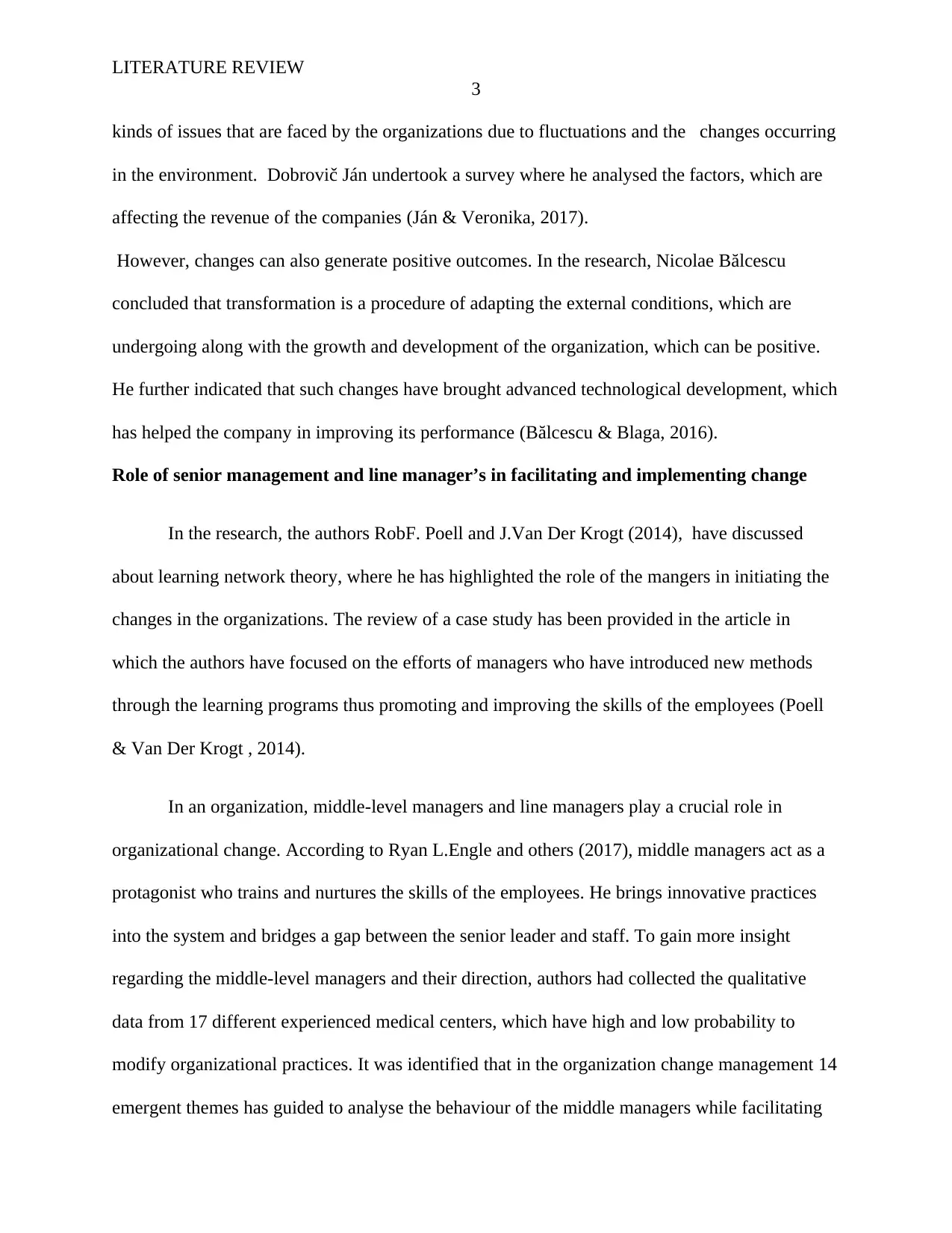
LITERATURE REVIEW
3
kinds of issues that are faced by the organizations due to fluctuations and the changes occurring
in the environment. Dobrovič Ján undertook a survey where he analysed the factors, which are
affecting the revenue of the companies (Ján & Veronika, 2017).
However, changes can also generate positive outcomes. In the research, Nicolae Bălcescu
concluded that transformation is a procedure of adapting the external conditions, which are
undergoing along with the growth and development of the organization, which can be positive.
He further indicated that such changes have brought advanced technological development, which
has helped the company in improving its performance (Bălcescu & Blaga, 2016).
Role of senior management and line manager’s in facilitating and implementing change
In the research, the authors RobF. Poell and J.Van Der Krogt (2014), have discussed
about learning network theory, where he has highlighted the role of the mangers in initiating the
changes in the organizations. The review of a case study has been provided in the article in
which the authors have focused on the efforts of managers who have introduced new methods
through the learning programs thus promoting and improving the skills of the employees (Poell
& Van Der Krogt , 2014).
In an organization, middle-level managers and line managers play a crucial role in
organizational change. According to Ryan L.Engle and others (2017), middle managers act as a
protagonist who trains and nurtures the skills of the employees. He brings innovative practices
into the system and bridges a gap between the senior leader and staff. To gain more insight
regarding the middle-level managers and their direction, authors had collected the qualitative
data from 17 different experienced medical centers, which have high and low probability to
modify organizational practices. It was identified that in the organization change management 14
emergent themes has guided to analyse the behaviour of the middle managers while facilitating
3
kinds of issues that are faced by the organizations due to fluctuations and the changes occurring
in the environment. Dobrovič Ján undertook a survey where he analysed the factors, which are
affecting the revenue of the companies (Ján & Veronika, 2017).
However, changes can also generate positive outcomes. In the research, Nicolae Bălcescu
concluded that transformation is a procedure of adapting the external conditions, which are
undergoing along with the growth and development of the organization, which can be positive.
He further indicated that such changes have brought advanced technological development, which
has helped the company in improving its performance (Bălcescu & Blaga, 2016).
Role of senior management and line manager’s in facilitating and implementing change
In the research, the authors RobF. Poell and J.Van Der Krogt (2014), have discussed
about learning network theory, where he has highlighted the role of the mangers in initiating the
changes in the organizations. The review of a case study has been provided in the article in
which the authors have focused on the efforts of managers who have introduced new methods
through the learning programs thus promoting and improving the skills of the employees (Poell
& Van Der Krogt , 2014).
In an organization, middle-level managers and line managers play a crucial role in
organizational change. According to Ryan L.Engle and others (2017), middle managers act as a
protagonist who trains and nurtures the skills of the employees. He brings innovative practices
into the system and bridges a gap between the senior leader and staff. To gain more insight
regarding the middle-level managers and their direction, authors had collected the qualitative
data from 17 different experienced medical centers, which have high and low probability to
modify organizational practices. It was identified that in the organization change management 14
emergent themes has guided to analyse the behaviour of the middle managers while facilitating
Paraphrase This Document
Need a fresh take? Get an instant paraphrase of this document with our AI Paraphraser
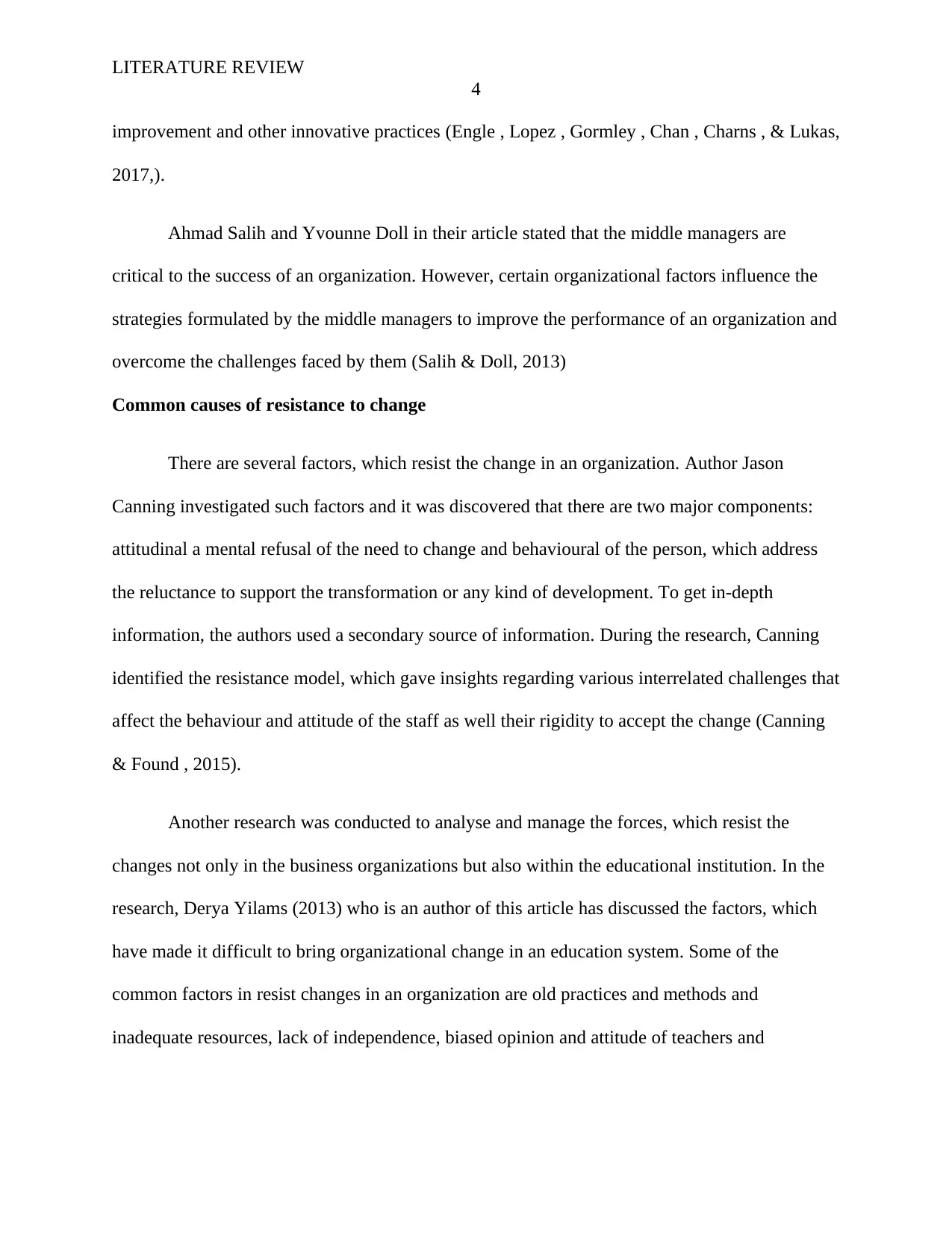
LITERATURE REVIEW
4
improvement and other innovative practices (Engle , Lopez , Gormley , Chan , Charns , & Lukas,
2017,).
Ahmad Salih and Yvounne Doll in their article stated that the middle managers are
critical to the success of an organization. However, certain organizational factors influence the
strategies formulated by the middle managers to improve the performance of an organization and
overcome the challenges faced by them (Salih & Doll, 2013)
Common causes of resistance to change
There are several factors, which resist the change in an organization. Author Jason
Canning investigated such factors and it was discovered that there are two major components:
attitudinal a mental refusal of the need to change and behavioural of the person, which address
the reluctance to support the transformation or any kind of development. To get in-depth
information, the authors used a secondary source of information. During the research, Canning
identified the resistance model, which gave insights regarding various interrelated challenges that
affect the behaviour and attitude of the staff as well their rigidity to accept the change (Canning
& Found , 2015).
Another research was conducted to analyse and manage the forces, which resist the
changes not only in the business organizations but also within the educational institution. In the
research, Derya Yilams (2013) who is an author of this article has discussed the factors, which
have made it difficult to bring organizational change in an education system. Some of the
common factors in resist changes in an organization are old practices and methods and
inadequate resources, lack of independence, biased opinion and attitude of teachers and
4
improvement and other innovative practices (Engle , Lopez , Gormley , Chan , Charns , & Lukas,
2017,).
Ahmad Salih and Yvounne Doll in their article stated that the middle managers are
critical to the success of an organization. However, certain organizational factors influence the
strategies formulated by the middle managers to improve the performance of an organization and
overcome the challenges faced by them (Salih & Doll, 2013)
Common causes of resistance to change
There are several factors, which resist the change in an organization. Author Jason
Canning investigated such factors and it was discovered that there are two major components:
attitudinal a mental refusal of the need to change and behavioural of the person, which address
the reluctance to support the transformation or any kind of development. To get in-depth
information, the authors used a secondary source of information. During the research, Canning
identified the resistance model, which gave insights regarding various interrelated challenges that
affect the behaviour and attitude of the staff as well their rigidity to accept the change (Canning
& Found , 2015).
Another research was conducted to analyse and manage the forces, which resist the
changes not only in the business organizations but also within the educational institution. In the
research, Derya Yilams (2013) who is an author of this article has discussed the factors, which
have made it difficult to bring organizational change in an education system. Some of the
common factors in resist changes in an organization are old practices and methods and
inadequate resources, lack of independence, biased opinion and attitude of teachers and
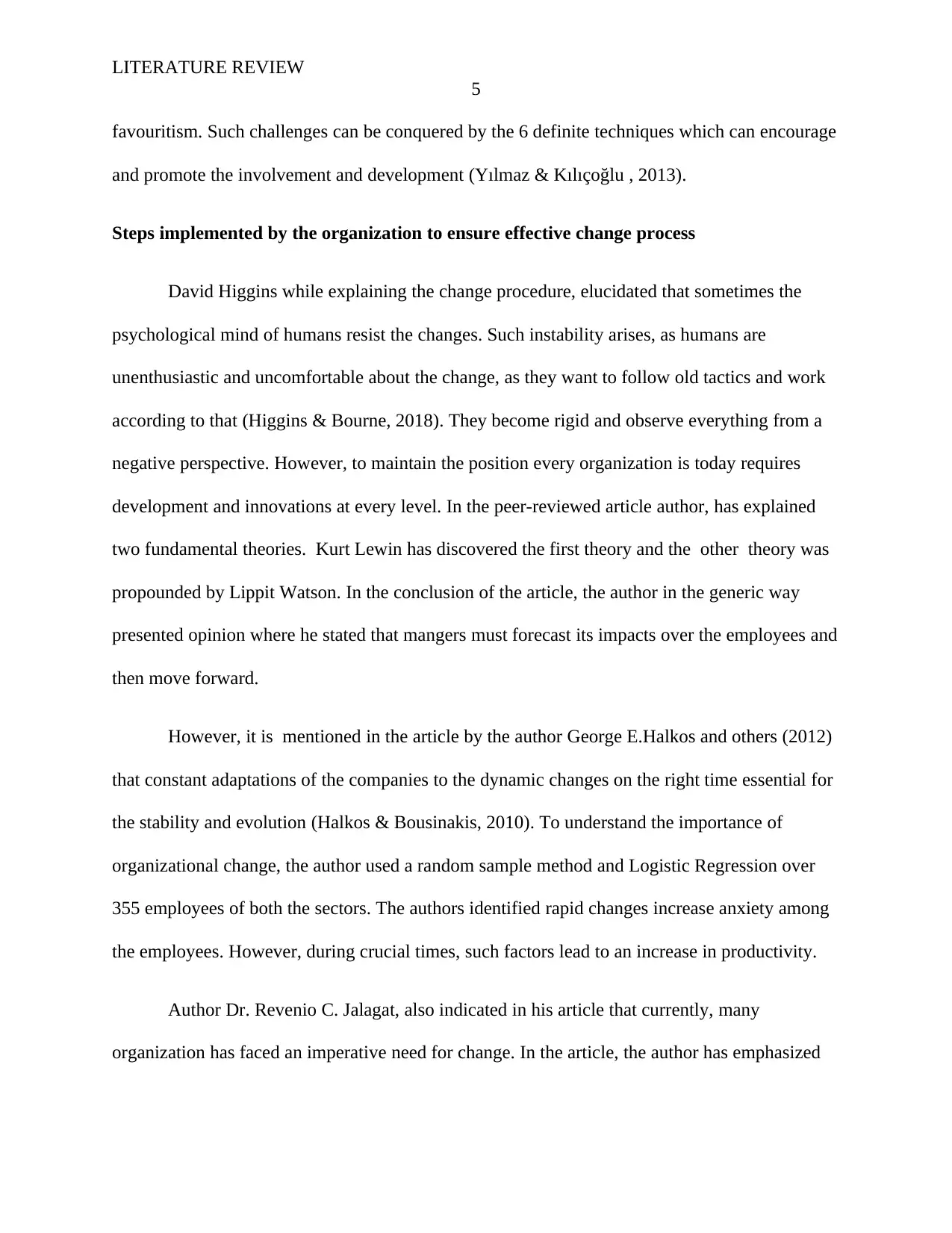
LITERATURE REVIEW
5
favouritism. Such challenges can be conquered by the 6 definite techniques which can encourage
and promote the involvement and development (Yılmaz & Kılıçoğlu , 2013).
Steps implemented by the organization to ensure effective change process
David Higgins while explaining the change procedure, elucidated that sometimes the
psychological mind of humans resist the changes. Such instability arises, as humans are
unenthusiastic and uncomfortable about the change, as they want to follow old tactics and work
according to that (Higgins & Bourne, 2018). They become rigid and observe everything from a
negative perspective. However, to maintain the position every organization is today requires
development and innovations at every level. In the peer-reviewed article author, has explained
two fundamental theories. Kurt Lewin has discovered the first theory and the other theory was
propounded by Lippit Watson. In the conclusion of the article, the author in the generic way
presented opinion where he stated that mangers must forecast its impacts over the employees and
then move forward.
However, it is mentioned in the article by the author George E.Halkos and others (2012)
that constant adaptations of the companies to the dynamic changes on the right time essential for
the stability and evolution (Halkos & Bousinakis, 2010). To understand the importance of
organizational change, the author used a random sample method and Logistic Regression over
355 employees of both the sectors. The authors identified rapid changes increase anxiety among
the employees. However, during crucial times, such factors lead to an increase in productivity.
Author Dr. Revenio C. Jalagat, also indicated in his article that currently, many
organization has faced an imperative need for change. In the article, the author has emphasized
5
favouritism. Such challenges can be conquered by the 6 definite techniques which can encourage
and promote the involvement and development (Yılmaz & Kılıçoğlu , 2013).
Steps implemented by the organization to ensure effective change process
David Higgins while explaining the change procedure, elucidated that sometimes the
psychological mind of humans resist the changes. Such instability arises, as humans are
unenthusiastic and uncomfortable about the change, as they want to follow old tactics and work
according to that (Higgins & Bourne, 2018). They become rigid and observe everything from a
negative perspective. However, to maintain the position every organization is today requires
development and innovations at every level. In the peer-reviewed article author, has explained
two fundamental theories. Kurt Lewin has discovered the first theory and the other theory was
propounded by Lippit Watson. In the conclusion of the article, the author in the generic way
presented opinion where he stated that mangers must forecast its impacts over the employees and
then move forward.
However, it is mentioned in the article by the author George E.Halkos and others (2012)
that constant adaptations of the companies to the dynamic changes on the right time essential for
the stability and evolution (Halkos & Bousinakis, 2010). To understand the importance of
organizational change, the author used a random sample method and Logistic Regression over
355 employees of both the sectors. The authors identified rapid changes increase anxiety among
the employees. However, during crucial times, such factors lead to an increase in productivity.
Author Dr. Revenio C. Jalagat, also indicated in his article that currently, many
organization has faced an imperative need for change. In the article, the author has emphasized
⊘ This is a preview!⊘
Do you want full access?
Subscribe today to unlock all pages.

Trusted by 1+ million students worldwide
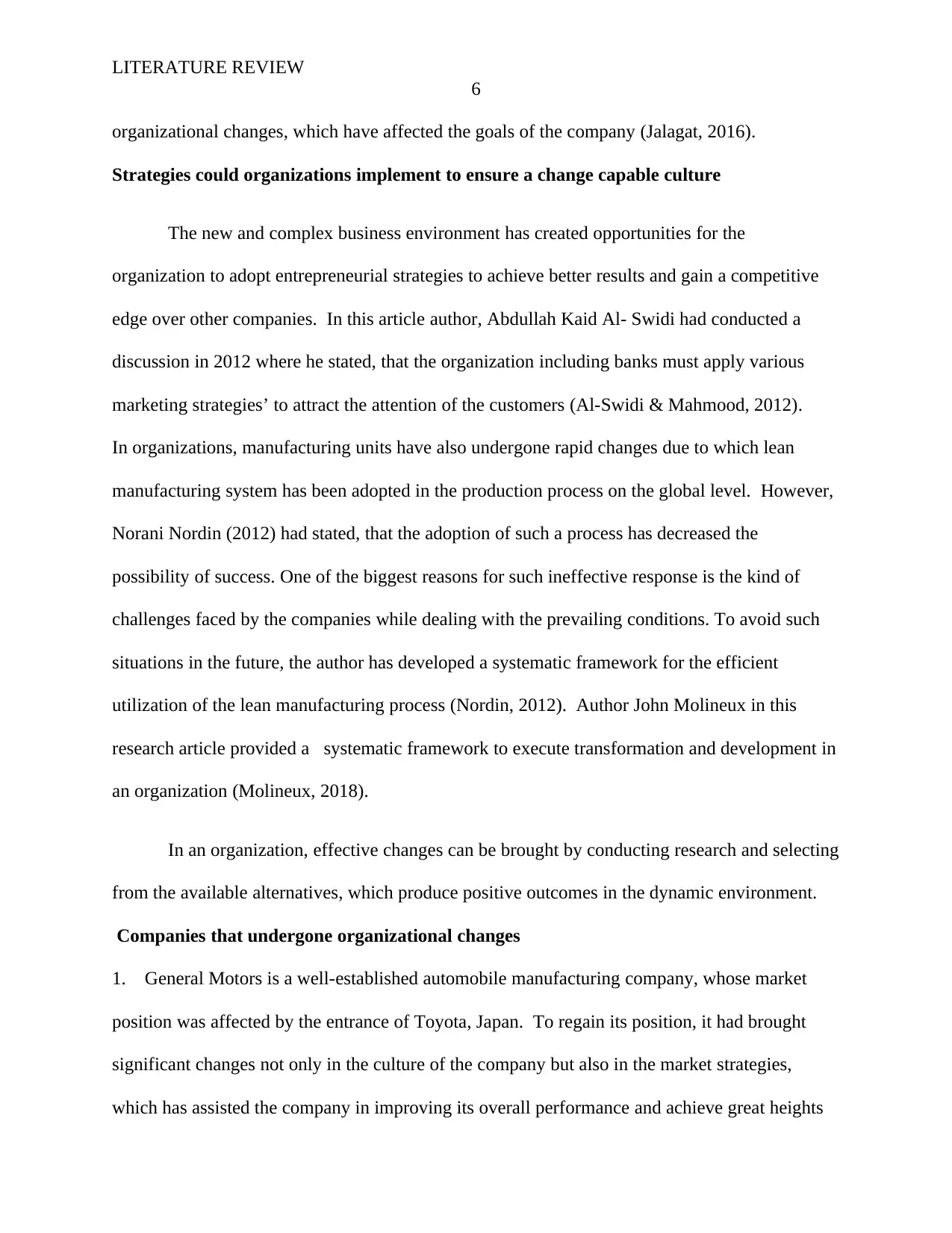
LITERATURE REVIEW
6
organizational changes, which have affected the goals of the company (Jalagat, 2016).
Strategies could organizations implement to ensure a change capable culture
The new and complex business environment has created opportunities for the
organization to adopt entrepreneurial strategies to achieve better results and gain a competitive
edge over other companies. In this article author, Abdullah Kaid Al- Swidi had conducted a
discussion in 2012 where he stated, that the organization including banks must apply various
marketing strategies’ to attract the attention of the customers (Al-Swidi & Mahmood, 2012).
In organizations, manufacturing units have also undergone rapid changes due to which lean
manufacturing system has been adopted in the production process on the global level. However,
Norani Nordin (2012) had stated, that the adoption of such a process has decreased the
possibility of success. One of the biggest reasons for such ineffective response is the kind of
challenges faced by the companies while dealing with the prevailing conditions. To avoid such
situations in the future, the author has developed a systematic framework for the efficient
utilization of the lean manufacturing process (Nordin, 2012). Author John Molineux in this
research article provided a systematic framework to execute transformation and development in
an organization (Molineux, 2018).
In an organization, effective changes can be brought by conducting research and selecting
from the available alternatives, which produce positive outcomes in the dynamic environment.
Companies that undergone organizational changes
1. General Motors is a well-established automobile manufacturing company, whose market
position was affected by the entrance of Toyota, Japan. To regain its position, it had brought
significant changes not only in the culture of the company but also in the market strategies,
which has assisted the company in improving its overall performance and achieve great heights
6
organizational changes, which have affected the goals of the company (Jalagat, 2016).
Strategies could organizations implement to ensure a change capable culture
The new and complex business environment has created opportunities for the
organization to adopt entrepreneurial strategies to achieve better results and gain a competitive
edge over other companies. In this article author, Abdullah Kaid Al- Swidi had conducted a
discussion in 2012 where he stated, that the organization including banks must apply various
marketing strategies’ to attract the attention of the customers (Al-Swidi & Mahmood, 2012).
In organizations, manufacturing units have also undergone rapid changes due to which lean
manufacturing system has been adopted in the production process on the global level. However,
Norani Nordin (2012) had stated, that the adoption of such a process has decreased the
possibility of success. One of the biggest reasons for such ineffective response is the kind of
challenges faced by the companies while dealing with the prevailing conditions. To avoid such
situations in the future, the author has developed a systematic framework for the efficient
utilization of the lean manufacturing process (Nordin, 2012). Author John Molineux in this
research article provided a systematic framework to execute transformation and development in
an organization (Molineux, 2018).
In an organization, effective changes can be brought by conducting research and selecting
from the available alternatives, which produce positive outcomes in the dynamic environment.
Companies that undergone organizational changes
1. General Motors is a well-established automobile manufacturing company, whose market
position was affected by the entrance of Toyota, Japan. To regain its position, it had brought
significant changes not only in the culture of the company but also in the market strategies,
which has assisted the company in improving its overall performance and achieve great heights
Paraphrase This Document
Need a fresh take? Get an instant paraphrase of this document with our AI Paraphraser
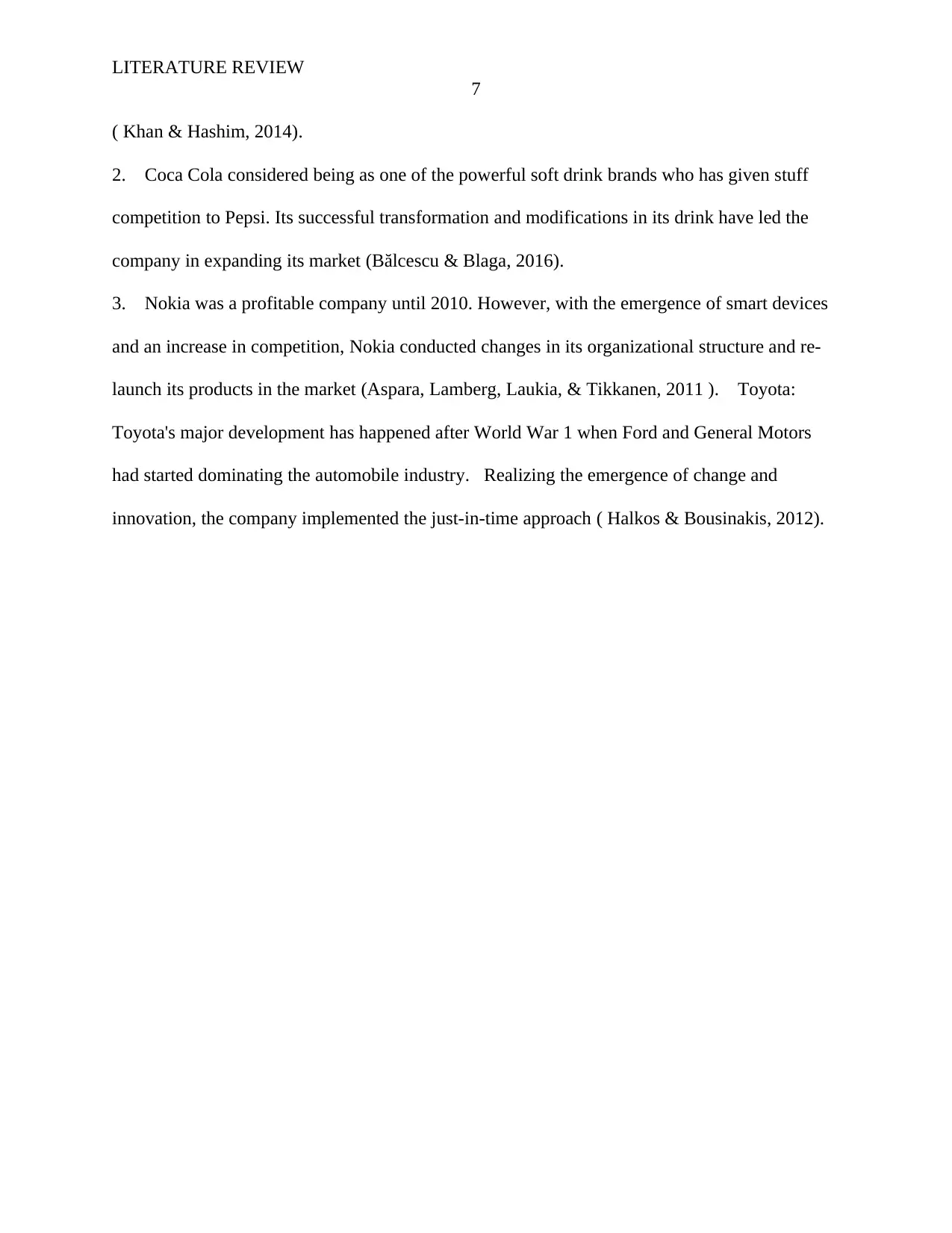
LITERATURE REVIEW
7
( Khan & Hashim, 2014).
2. Coca Cola considered being as one of the powerful soft drink brands who has given stuff
competition to Pepsi. Its successful transformation and modifications in its drink have led the
company in expanding its market (Bălcescu & Blaga, 2016).
3. Nokia was a profitable company until 2010. However, with the emergence of smart devices
and an increase in competition, Nokia conducted changes in its organizational structure and re-
launch its products in the market (Aspara, Lamberg, Laukia, & Tikkanen, 2011 ). Toyota:
Toyota's major development has happened after World War 1 when Ford and General Motors
had started dominating the automobile industry. Realizing the emergence of change and
innovation, the company implemented the just-in-time approach ( Halkos & Bousinakis, 2012).
7
( Khan & Hashim, 2014).
2. Coca Cola considered being as one of the powerful soft drink brands who has given stuff
competition to Pepsi. Its successful transformation and modifications in its drink have led the
company in expanding its market (Bălcescu & Blaga, 2016).
3. Nokia was a profitable company until 2010. However, with the emergence of smart devices
and an increase in competition, Nokia conducted changes in its organizational structure and re-
launch its products in the market (Aspara, Lamberg, Laukia, & Tikkanen, 2011 ). Toyota:
Toyota's major development has happened after World War 1 when Ford and General Motors
had started dominating the automobile industry. Realizing the emergence of change and
innovation, the company implemented the just-in-time approach ( Halkos & Bousinakis, 2012).
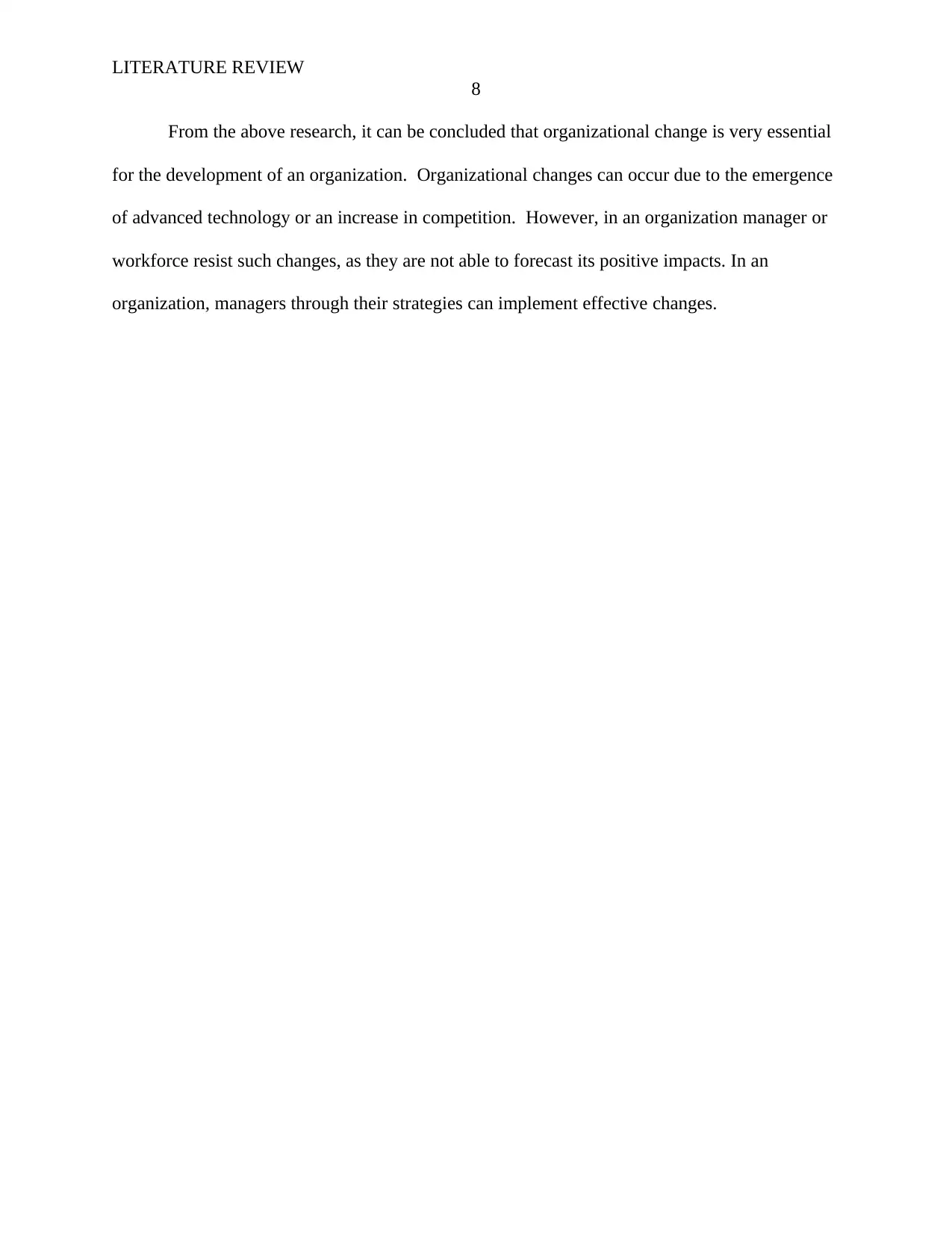
LITERATURE REVIEW
8
From the above research, it can be concluded that organizational change is very essential
for the development of an organization. Organizational changes can occur due to the emergence
of advanced technology or an increase in competition. However, in an organization manager or
workforce resist such changes, as they are not able to forecast its positive impacts. In an
organization, managers through their strategies can implement effective changes.
8
From the above research, it can be concluded that organizational change is very essential
for the development of an organization. Organizational changes can occur due to the emergence
of advanced technology or an increase in competition. However, in an organization manager or
workforce resist such changes, as they are not able to forecast its positive impacts. In an
organization, managers through their strategies can implement effective changes.
⊘ This is a preview!⊘
Do you want full access?
Subscribe today to unlock all pages.

Trusted by 1+ million students worldwide
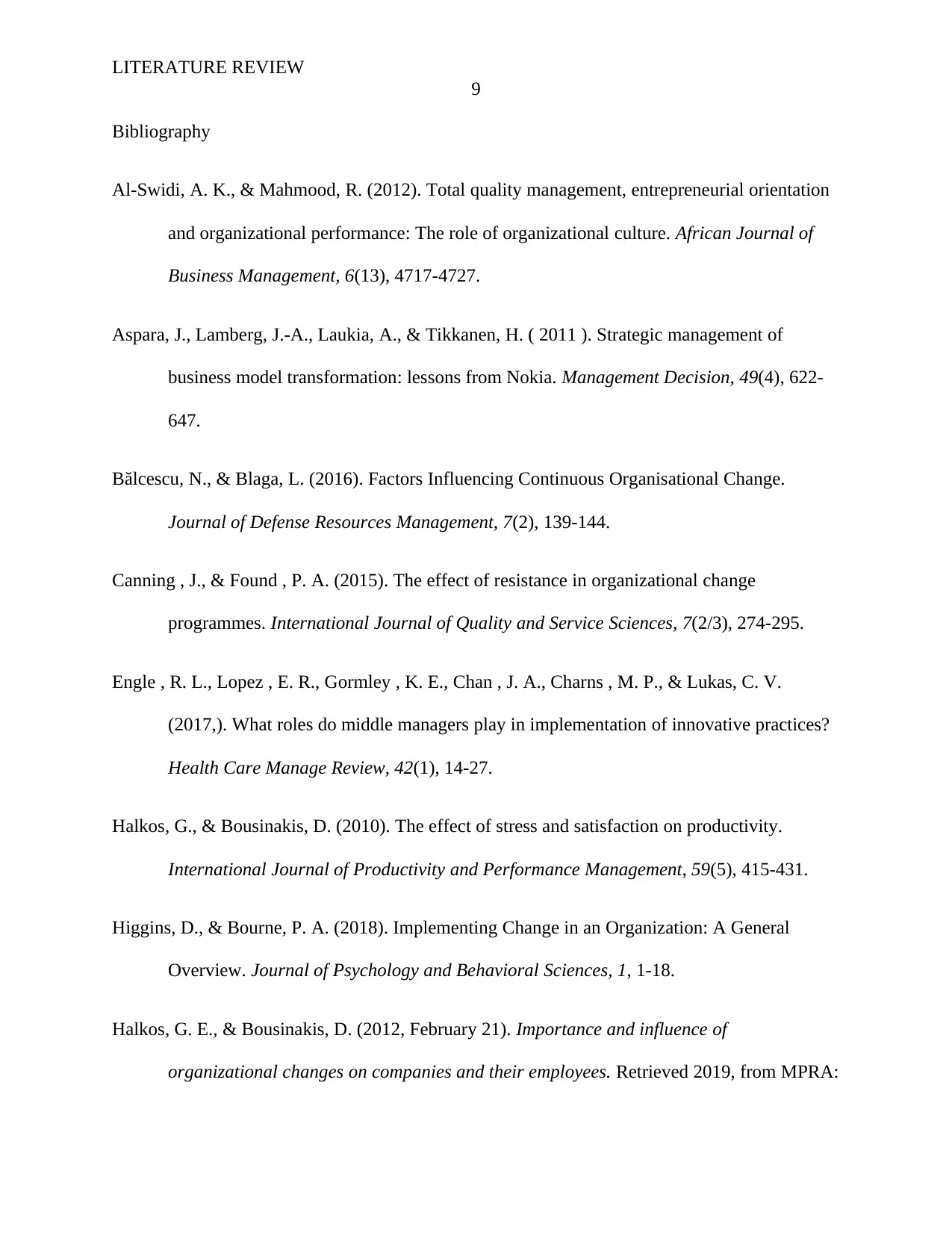
LITERATURE REVIEW
9
Bibliography
Al-Swidi, A. K., & Mahmood, R. (2012). Total quality management, entrepreneurial orientation
and organizational performance: The role of organizational culture. African Journal of
Business Management, 6(13), 4717-4727.
Aspara, J., Lamberg, J.-A., Laukia, A., & Tikkanen, H. ( 2011 ). Strategic management of
business model transformation: lessons from Nokia. Management Decision, 49(4), 622-
647.
Bălcescu, N., & Blaga, L. (2016). Factors Influencing Continuous Organisational Change.
Journal of Defense Resources Management, 7(2), 139-144.
Canning , J., & Found , P. A. (2015). The effect of resistance in organizational change
programmes. International Journal of Quality and Service Sciences, 7(2/3), 274-295.
Engle , R. L., Lopez , E. R., Gormley , K. E., Chan , J. A., Charns , M. P., & Lukas, C. V.
(2017,). What roles do middle managers play in implementation of innovative practices?
Health Care Manage Review, 42(1), 14-27.
Halkos, G., & Bousinakis, D. (2010). The effect of stress and satisfaction on productivity.
International Journal of Productivity and Performance Management, 59(5), 415-431.
Higgins, D., & Bourne, P. A. (2018). Implementing Change in an Organization: A General
Overview. Journal of Psychology and Behavioral Sciences, 1, 1-18.
Halkos, G. E., & Bousinakis, D. (2012, February 21). Importance and influence of
organizational changes on companies and their employees. Retrieved 2019, from MPRA:
9
Bibliography
Al-Swidi, A. K., & Mahmood, R. (2012). Total quality management, entrepreneurial orientation
and organizational performance: The role of organizational culture. African Journal of
Business Management, 6(13), 4717-4727.
Aspara, J., Lamberg, J.-A., Laukia, A., & Tikkanen, H. ( 2011 ). Strategic management of
business model transformation: lessons from Nokia. Management Decision, 49(4), 622-
647.
Bălcescu, N., & Blaga, L. (2016). Factors Influencing Continuous Organisational Change.
Journal of Defense Resources Management, 7(2), 139-144.
Canning , J., & Found , P. A. (2015). The effect of resistance in organizational change
programmes. International Journal of Quality and Service Sciences, 7(2/3), 274-295.
Engle , R. L., Lopez , E. R., Gormley , K. E., Chan , J. A., Charns , M. P., & Lukas, C. V.
(2017,). What roles do middle managers play in implementation of innovative practices?
Health Care Manage Review, 42(1), 14-27.
Halkos, G., & Bousinakis, D. (2010). The effect of stress and satisfaction on productivity.
International Journal of Productivity and Performance Management, 59(5), 415-431.
Higgins, D., & Bourne, P. A. (2018). Implementing Change in an Organization: A General
Overview. Journal of Psychology and Behavioral Sciences, 1, 1-18.
Halkos, G. E., & Bousinakis, D. (2012, February 21). Importance and influence of
organizational changes on companies and their employees. Retrieved 2019, from MPRA:
Paraphrase This Document
Need a fresh take? Get an instant paraphrase of this document with our AI Paraphraser
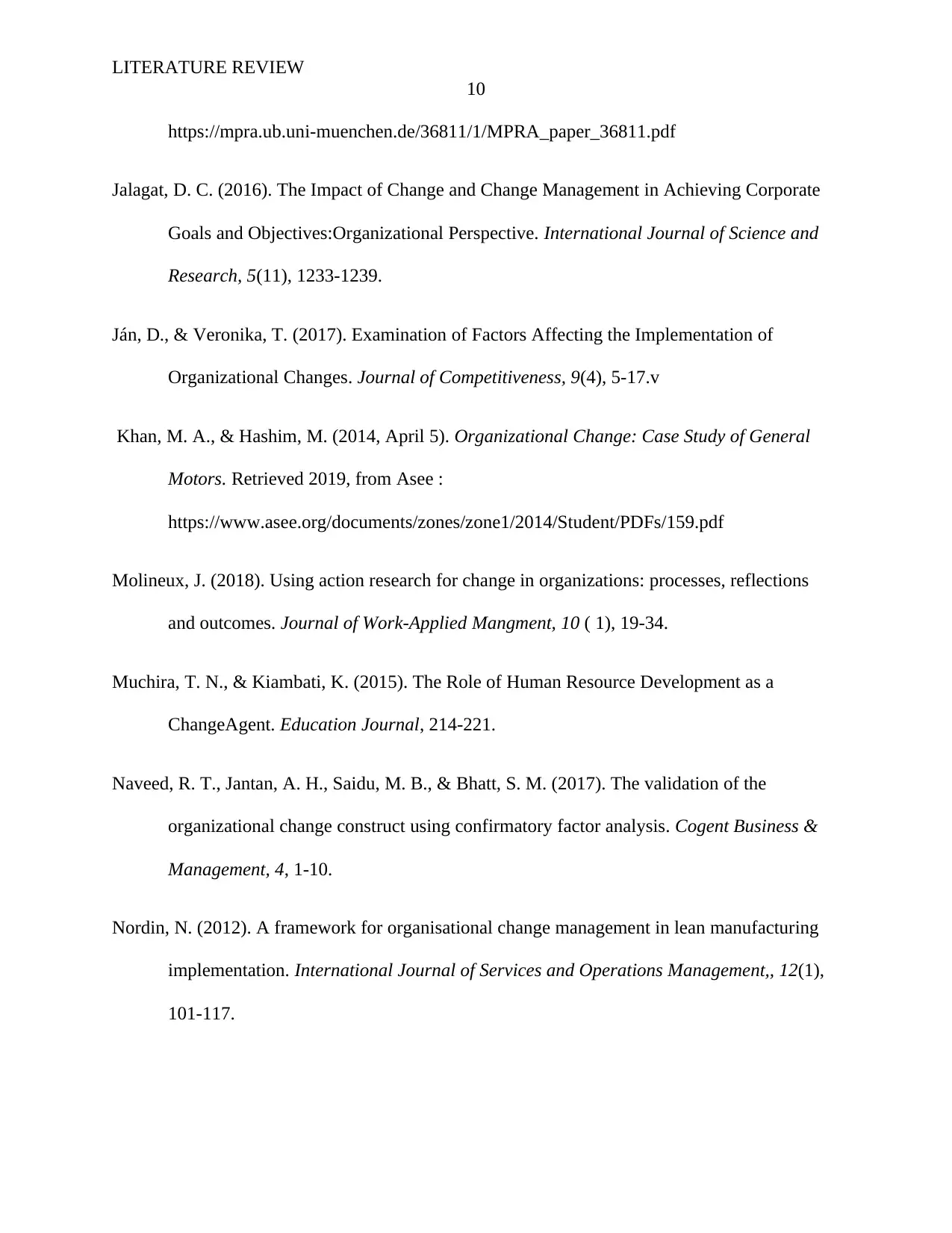
LITERATURE REVIEW
10
https://mpra.ub.uni-muenchen.de/36811/1/MPRA_paper_36811.pdf
Jalagat, D. C. (2016). The Impact of Change and Change Management in Achieving Corporate
Goals and Objectives:Organizational Perspective. International Journal of Science and
Research, 5(11), 1233-1239.
Ján, D., & Veronika, T. (2017). Examination of Factors Affecting the Implementation of
Organizational Changes. Journal of Competitiveness, 9(4), 5-17.v
Khan, M. A., & Hashim, M. (2014, April 5). Organizational Change: Case Study of General
Motors. Retrieved 2019, from Asee :
https://www.asee.org/documents/zones/zone1/2014/Student/PDFs/159.pdf
Molineux, J. (2018). Using action research for change in organizations: processes, reflections
and outcomes. Journal of Work-Applied Mangment, 10 ( 1), 19-34.
Muchira, T. N., & Kiambati, K. (2015). The Role of Human Resource Development as a
ChangeAgent. Education Journal, 214-221.
Naveed, R. T., Jantan, A. H., Saidu, M. B., & Bhatt, S. M. (2017). The validation of the
organizational change construct using confirmatory factor analysis. Cogent Business &
Management, 4, 1-10.
Nordin, N. (2012). A framework for organisational change management in lean manufacturing
implementation. International Journal of Services and Operations Management,, 12(1),
101-117.
10
https://mpra.ub.uni-muenchen.de/36811/1/MPRA_paper_36811.pdf
Jalagat, D. C. (2016). The Impact of Change and Change Management in Achieving Corporate
Goals and Objectives:Organizational Perspective. International Journal of Science and
Research, 5(11), 1233-1239.
Ján, D., & Veronika, T. (2017). Examination of Factors Affecting the Implementation of
Organizational Changes. Journal of Competitiveness, 9(4), 5-17.v
Khan, M. A., & Hashim, M. (2014, April 5). Organizational Change: Case Study of General
Motors. Retrieved 2019, from Asee :
https://www.asee.org/documents/zones/zone1/2014/Student/PDFs/159.pdf
Molineux, J. (2018). Using action research for change in organizations: processes, reflections
and outcomes. Journal of Work-Applied Mangment, 10 ( 1), 19-34.
Muchira, T. N., & Kiambati, K. (2015). The Role of Human Resource Development as a
ChangeAgent. Education Journal, 214-221.
Naveed, R. T., Jantan, A. H., Saidu, M. B., & Bhatt, S. M. (2017). The validation of the
organizational change construct using confirmatory factor analysis. Cogent Business &
Management, 4, 1-10.
Nordin, N. (2012). A framework for organisational change management in lean manufacturing
implementation. International Journal of Services and Operations Management,, 12(1),
101-117.
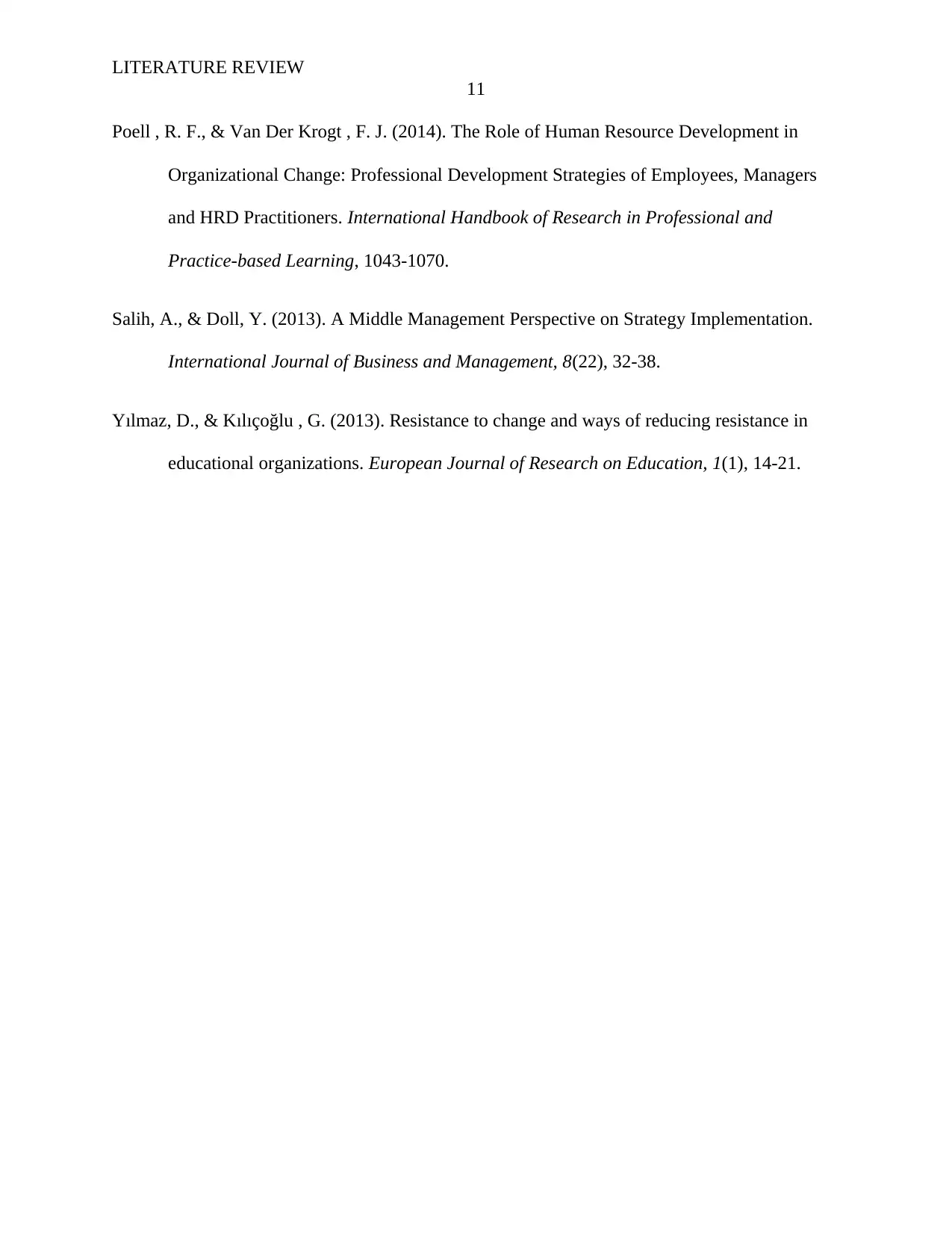
LITERATURE REVIEW
11
Poell , R. F., & Van Der Krogt , F. J. (2014). The Role of Human Resource Development in
Organizational Change: Professional Development Strategies of Employees, Managers
and HRD Practitioners. International Handbook of Research in Professional and
Practice-based Learning, 1043-1070.
Salih, A., & Doll, Y. (2013). A Middle Management Perspective on Strategy Implementation.
International Journal of Business and Management, 8(22), 32-38.
Yılmaz, D., & Kılıçoğlu , G. (2013). Resistance to change and ways of reducing resistance in
educational organizations. European Journal of Research on Education, 1(1), 14-21.
11
Poell , R. F., & Van Der Krogt , F. J. (2014). The Role of Human Resource Development in
Organizational Change: Professional Development Strategies of Employees, Managers
and HRD Practitioners. International Handbook of Research in Professional and
Practice-based Learning, 1043-1070.
Salih, A., & Doll, Y. (2013). A Middle Management Perspective on Strategy Implementation.
International Journal of Business and Management, 8(22), 32-38.
Yılmaz, D., & Kılıçoğlu , G. (2013). Resistance to change and ways of reducing resistance in
educational organizations. European Journal of Research on Education, 1(1), 14-21.
⊘ This is a preview!⊘
Do you want full access?
Subscribe today to unlock all pages.

Trusted by 1+ million students worldwide
1 out of 12
Related Documents
Your All-in-One AI-Powered Toolkit for Academic Success.
+13062052269
info@desklib.com
Available 24*7 on WhatsApp / Email
![[object Object]](/_next/static/media/star-bottom.7253800d.svg)
Unlock your academic potential
Copyright © 2020–2025 A2Z Services. All Rights Reserved. Developed and managed by ZUCOL.





